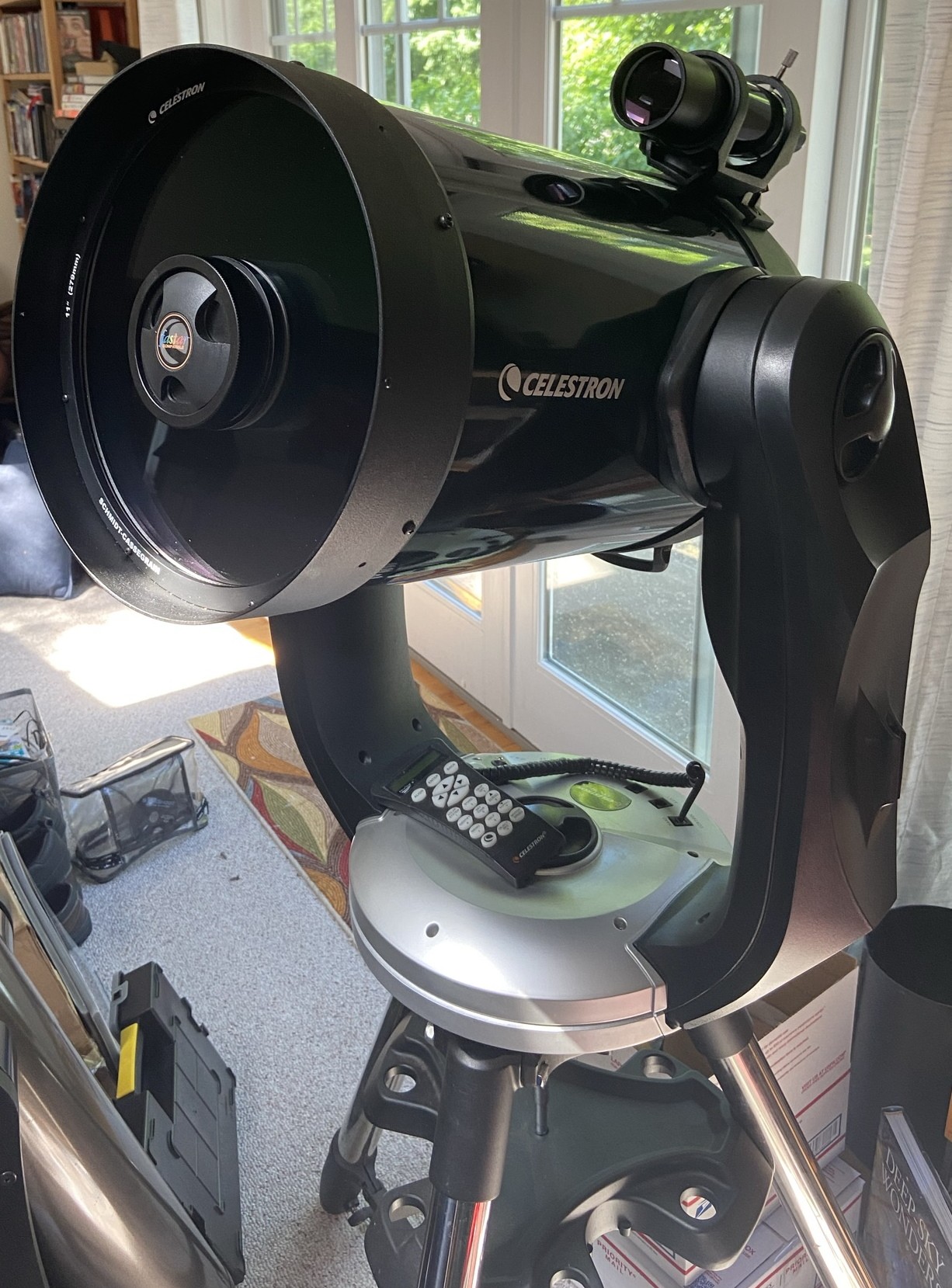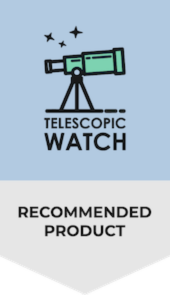The C11 XLT Optical Tube
The Celestron C11 telescope was the last of Celestron’s original orange tube models to debut, appearing in the early 1980s alongside the C90 Maksutov and accompanying the C5, C8, and C14. The C11 was made as a more portable option to supplement the C14, which could technically be transported but was, in practice, a permanent observatory instrument atop its fork mount (and is arguably still one today).
The C11 is an 11” (280mm) f/10 Schmidt-Cassegrain telescope with a focal length of 2800mm. The new XLT version has StarBright XLT coatings to slightly improve light transmission as well as compatibility with the Starizona HyperStar system.
The C11 XLT is comparable to a typical 12” Dobsonian for planetary viewing and imaging and comparable to a 10” Dobsonian for deep-sky observation, albeit with a much longer focal length.
I focus the C11 XLT by turning a knob at the back of the optical tube to move the primary mirror, as with most catadioptric telescopes. This can induce minor “image shift” when focusing during visual observation as well as “mirror flop” during long exposure astrophotography. But long-exposure imaging isn’t something I was doing with the CPC 1100 anyway, so it wasn’t much of a concern. The image shift is generally controlled.
Collimation of Schmidt-Cassegrain telescopes like the C11 XLT is done by adjusting three screws at the front of the optical tube to tip and tilt the secondary mirror. I point the scope at a bright star, put it out of focus, and adjust until the secondary mirror appears centred in the defocused view; our collimation guide explains more.
The C11 XLT uses a 3.25” rear thread for certain accessories but is also provided with an adaptor to fit any accessory with standard 2” SCT rear threads, such as the provided visual back, a screw-on 2” diagonal, or camera adaptors, reducers, and other accessories.
The scope is drilled to fit a dovetail plate on both the bottom and top of the tube, and it is possible, if somewhat inconvenient, to remove the telescope from the CPC fork arms to “defork” it and put the tube on a German equatorial mount.
The Accessory Set
The CPC 1100 GPS comes with a 9×50 finder scope, which provides an upside-down, flipped field of view of approximately 5 degrees with crosshairs for precise pointing. In my usage, the finder’s optics were decent, and the bracket held its alignment well even when the C11 XLT was transported. A magnifying finder might seem unnecessary with a GoTo telescope, but the C11 XLT’s extremely long 2800mm focal length means that the additional accuracy of a magnified finder scope is necessary to ensure that our alignment stars are in the telescope’s field of view.
A 1.25” visual back, 1.25” prism star diagonal, and 40mm E-Lux Plossl eyepiece are included too.
This eyepiece is limited by its barrel diameter to a 43-degree apparent field of view, which at 70x with the C11 XLT translates to a 0.6-degree true field; this is slightly wider than the full Moon in the sky. To achieve a wider field of view, a 2” star diagonal and eyepieces must be acquired in addition to any other desired eyepieces for higher powers, which you’ll probably also want.
The CPC Fork Mount
The Celestron CPC 1100 GPS mount is an impressive combination of a powerful GoTo altitude-azimuth fork mount, perched atop a sturdy steel tripod.
Setting up the scope was quite straightforward: I levelled the tripod and attached its tray, then simply hoisted the 30 kg tube/fork assembly onto the tripod, powered the mount up, and aligned it with a couple of stars, and I could then automatically point at anything I want while the mount hums away as it tracks the sky. The CPC’s internal clock and GPS system obviate the need to input any information at startup.
The mount uses Celestron’s standard NexStar+ hand controller with a 40,000+ object database, or you can add Celestron’s StarSense AutoAlign or SkyPortal WiFi dongle to the mount.
The gearing in the CPC forks allows for extremely accurate tracking, arguably overkill for imaging use. You could theoretically put the telescope on a wedge and convert it to an equatorial mount for astrophotography with suitable autoguiding accessories and a focal reducer. However, the CPC fork mount is nowhere near as economical or good for such a task as a dedicated German equatorial mount, and the C11 XLT’s extremely long focal length and less-than-flat field make it a pain to achieve sharp deep-sky images.
Astrophotography Capabilities
While technically usable for long-exposure imaging when coupled with a focal reducer or Starizona HyperStar and with an equatorial wedge installed, the Celestron CPC 1100 GPS is not really a scope I’d recommend for deep-sky astrophotography, though acceptable results can be obtained with autoguiding if you know what you are doing.
The CPC 1100 GPS is ideal for planetary imaging, but a 2x or 3x Barlow lens to increase the scope’s focal length to 5600-8400mm coupled with a high-speed planetary camera like the ZWO ASI224MC, allows me to get fabulous shots.
Should I buy a Used Celestron CPC 1100 GPS?
A used Celestron CPC 1100 GPS computerised telescope may have a failed GPS unit. This is not a huge concern; you can still manually input time/date/location information or connect a WiFi dongle and get the same data from your phone.
As usual, it’s also important to make sure that the mount powers up and tracks/slews smoothly.
Any damage to the C11 XLT optical tube is a sign of trouble; a broken corrector plate cannot be replaced without replacing the entire set of optics, and recoating corroded mirrors may similarly be more expensive than a new scope.
Aftermarket Accessories Recommendations
With a wide-angle 2” eyepiece paired with the CPC 1100, you can get a true field of view of just under 1 degree, which is far greater than what you would get with the stock 40mm E-Lux Plossl eyepiece.
For the best planetary viewing experience with the CPC 1100 GPS, as well as observing smaller deep-sky objects such as globular clusters and planetary nebulae, magnifications of 100x or higher are recommended. However, atmospheric seeing can limit you to no more than 200-300x on most nights, although the C11 XLT optics are nominally capable of handling up to 500x magnification.
To get started, a pair of eyepieces in the 16-22 mm range and 11-14 mm range would be a good idea, such as the Baader Hyperion 21mm (133x) or Explore Scientific 82-degree 18mm (156x) along with an Explore Scientific 82-degree 14mm (200x) or Baader Hyperion 13mm (215x) for the shorter focal length unit.
For higher magnification, shorter focal length eyepieces like the Explore Scientific 8.5mm 82-degree (329x) or 6.5mm 82-degree (430x) can be utilised if conditions permit it.
The telescope’s f/10 focal ratio will provide sharp images using any number of various optical designs and eyepiece lines available, so don’t hesitate to try something new! Additionally, attaching a Barlow lens to your existing eyepieces or investing in a planetary camera for imaging are viable options for further expanding your available magnification options.
Lastly, a power supply such as the Celestron PowerTank Lithium Pro is needed to run the CPC 1100 GPS, and you’ll almost certainly want a dew shield, which protects the telescope’s sensitive optical coatings from moisture damage as well as blocking out some stray light and reducing contact with dust, dirt, pollen, and bugs.
What can you see?
The Celestron CPC 1100 GPS is the perfect choice for deep-sky viewing and produces similar views to a 10-12” Dobsonian, apart from being limited to a much smaller field of view.
Even in light-polluted skies, I’m able to make out numerous open star clusters, such as M35, M11, M46, and M38, thanks to its impressive light-gathering power.
Globular star clusters like M3 and M22 appear with plenty of detail, and individual stars can easily be distinguished. Furthermore, specific features such as the dust lanes in M13 or the tight core of M15 are clearly visible through the CPC 1100’s eyepiece.
The Cat’s Eye, Blue Snowball, and Blinking Planetary Nebulae also reveal their vibrant colours through this telescope. Larger planetary nebulae such as the Helix Nebula, Ring Nebula (M57), and Dumbbell Nebula (M27) look fantastic, and even in highly light-polluted locations, I can see sights such as the Orion Nebula (M42) and Lagoon Nebula (M8), although using a UHC filter is recommended for better results along with dark skies. There are also plenty of double stars you can go after with the CPC 1100, even under brightly lit city skies.
Under severely light-polluted skies, galaxies are practically invisible or devoid of detail. However, when viewed through the CPC 1100 GPS under darker viewing conditions, these same galaxies explode with detail; hundreds can be viewed in the Virgo and Coma Berenices clusters, and the dust lanes in galaxies such as M82 or M104 can easily be seen. Under very dark and transparent skies, I can even resolve the spiral arms of M51!
The CPC 1100 GPS is also a great telescope for lunar and planetary observation. You can use eyepieces without exotic optical designs or ultra-short focal lengths thanks to the scope’s long 2800mm focal length, forgiving f/10 focal ratio, and motorised tracking.
- I could see endless tiny details on the Moon such as craters, mountains, and ridges, while the phases of Mercury and Venus are easily resolved.
- Mars shows various dark markings and its polar ice caps when the planet is at its closest to us, while Jupiter reveals colourful cloud belts and other atmospheric details, including the Great Red Spot. Jupiter’s four large Galilean moons are easily resolved as disks, along with their shadows during a transit, and Ganymede may show a surface feature or two.
- Saturn’s rings and the Cassini division in them are a delight, and very good seeing conditions will also permit the CPC 1100 GPS to resolve the Encke gap in the rings too. Saturn also shows cloud belts of its own and a handful of moons.
- Uranus’ turquoise disk is resolved along with up to four moons, while Neptune often remains a fuzzy blob, but its moon Triton is clearly visible next to it.
- The CPC 1100 GPS can also pick up Pluto as a star-like point, albeit barely and only under dark skies.



